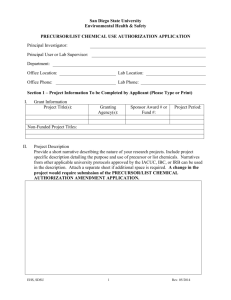ASSIGNMENT #2: Designing a set of experiments for a... Due: 2 days after session 6 NOTE:
advertisement
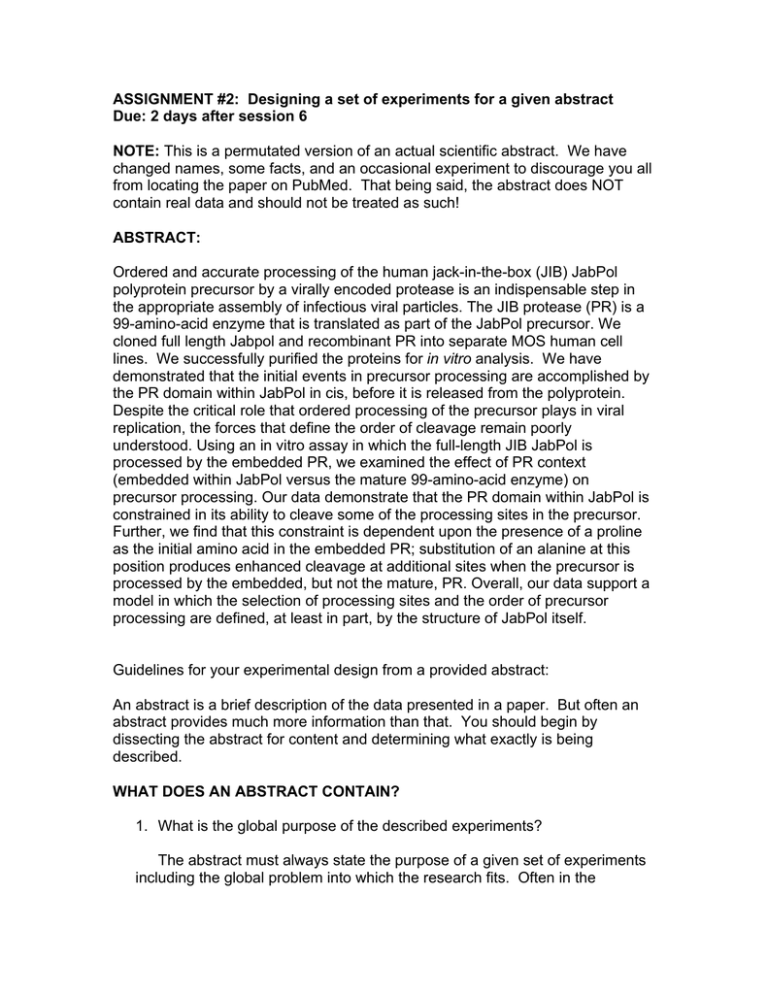
ASSIGNMENT #2: Designing a set of experiments for a given abstract Due: 2 days after session 6 NOTE: This is a permutated version of an actual scientific abstract. We have changed names, some facts, and an occasional experiment to discourage you all from locating the paper on PubMed. That being said, the abstract does NOT contain real data and should not be treated as such! ABSTRACT: Ordered and accurate processing of the human jack-in-the-box (JIB) JabPol polyprotein precursor by a virally encoded protease is an indispensable step in the appropriate assembly of infectious viral particles. The JIB protease (PR) is a 99-amino-acid enzyme that is translated as part of the JabPol precursor. We cloned full length Jabpol and recombinant PR into separate MOS human cell lines. We successfully purified the proteins for in vitro analysis. We have demonstrated that the initial events in precursor processing are accomplished by the PR domain within JabPol in cis, before it is released from the polyprotein. Despite the critical role that ordered processing of the precursor plays in viral replication, the forces that define the order of cleavage remain poorly understood. Using an in vitro assay in which the full-length JIB JabPol is processed by the embedded PR, we examined the effect of PR context (embedded within JabPol versus the mature 99-amino-acid enzyme) on precursor processing. Our data demonstrate that the PR domain within JabPol is constrained in its ability to cleave some of the processing sites in the precursor. Further, we find that this constraint is dependent upon the presence of a proline as the initial amino acid in the embedded PR; substitution of an alanine at this position produces enhanced cleavage at additional sites when the precursor is processed by the embedded, but not the mature, PR. Overall, our data support a model in which the selection of processing sites and the order of precursor processing are defined, at least in part, by the structure of JabPol itself. Guidelines for your experimental design from a provided abstract: An abstract is a brief description of the data presented in a paper. But often an abstract provides much more information than that. You should begin by dissecting the abstract for content and determining what exactly is being described. WHAT DOES AN ABSTRACT CONTAIN? 1. What is the global purpose of the described experiments? The abstract must always state the purpose of a given set of experiments including the global problem into which the research fits. Often in the biological sciences we are working on a small facet of a much more global disease or disorder. The global impact of the work should be mentioned as well as the hypothesis directly addressed by the subsequent experiments. For example, if I was working on identifying specific interaction partners of the BRAC1 protein, my global purpose would be to elucidate the mechanism of breast cancer formation in humans. 2. What is the specific purpose addressed? The hypothesis is the question directly addressed in the experimental work. This is sometimes includes a purpose to the experiments and often is very specific to the work. Following our aforementioned example, my purpose would be to determine the interaction partners of BRAC1. 3. What methods did the authors use to study their problem? Often in an abstract, the experimental techniques are described briefly or not all. Make a list for yourself of what techniques they do describe. In my BRAC1 paper, I might say: A yeast two-hybrid screen was used to identify potential binding partners of BRAC1. 4. What was their result? This usually encompasses the majority of the abstract. This is new and authors want anyone who reads his/her abstract to come away believing the result and not getting bogged down in experimental detail. For example: Analysis of many different kinases revealed that only FAKE1 and FAKE2 were able to interact with BRAC1. 5. How does this relate to the original problem? What are the implications of this result? For example: This suggests that BRAC1 has only limited involvement in the Ras signaling pathway in the cell and is, therefore, unrelated to colon cancer. ASSIGNMENT You must now begin to think to yourself what else would have to be done to get the stated result. For example: How was the virus purified? What type of virus was it? What dyes did they use? What kind of animals, if any, did they use? Why? Were they recombinant? If so, how did they make? What controls did they use/need? Answers to these types of questions will be the majority of your write-up. You must describe all experiments that led to the result(s) of the abstract. We do not expect you to describe insignificant details such as your buffer concentration, but we do expect a level of detail from which one could actually design a preliminary set of experiments. For example, if you feel you should maintain physiological pH throughout your experiments, state that and explain why. WRITTEN SUBMISSION 1. 2. 3. 4. Avoid stylistic writing that expresses thoughts and feelings. Unfortunately, as scientists, we are encouraged to be stoic and not to express our opinions unless in reference to future directions of experimental work. Do not use “I” or “we”. Although pronouns are beginning to resurface as an acceptable form of scientific communication, they encourage the inclusion of feelings or thoughts which are not appropriate to describe solid experiments. Your experimental design write-up should consist of 2 pages (double spaced). You can include diagrams, but it is not a requirement and they should be included in addition to your page requirement. Your written submission must include references. You did not invent the techniques you are describing yourself! You must reference a paper in which the technique is used similarly or at least a textbox chapter describing it. You may use any acceptable scientific format that includes article titles, author names, journal title, volume, year, and page numbers. As always, you should feel free to contact us with any question or concerns you may have.
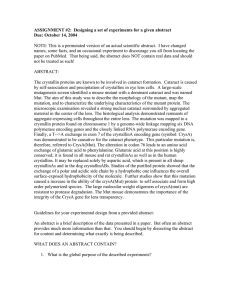

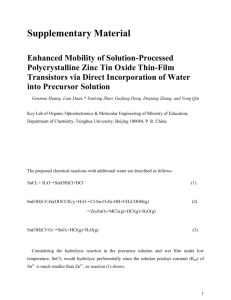



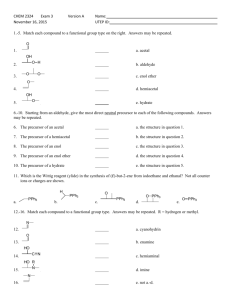
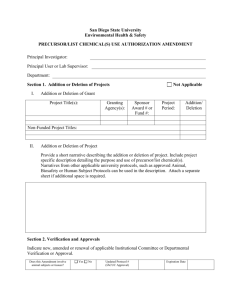
![Anti-Myeloid Precursor Cells antibody [ER-MP58] ab63860](http://s2.studylib.net/store/data/012462166_1-e5886b0a92755c9046e4cae18d1d42da-300x300.png)
